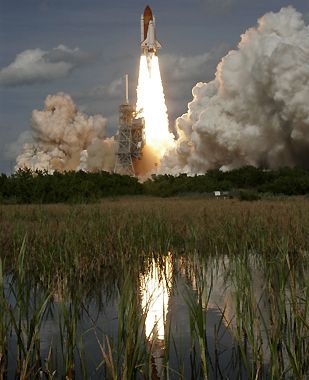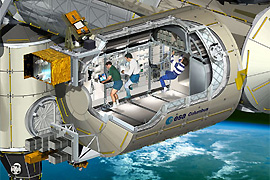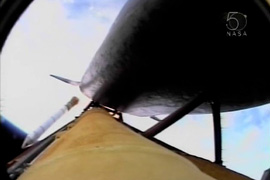Shuttle takes European lab to space
European-built space lab is first space station module not built in US or Russia.

Three spacewalks are scheduled during the mission, which includes astronauts Leopold Eyharts of France and Hans Schlegel of Germany among its seven-member crew.
Eyharts is due to replace US astronaut Dan Tani on board the space station for a two month stay in orbit.
Michael Griffin, head of the US space agency Nasa, said Thursday’s launch was a “momentous” moment, bringing “truly international capabilities and participation” to the space station.
 |
| The launch of Columbus marks a major step forward for Europe’s space efforts [ESA] |
“It shows visibly and in actuality that this is a real partnership among nations and societies to bring together a capability greater than anyone nation could bring by itself.”
Able to accommodate up to three people and backed up by ground staff at a control centre near Munich, Germany, the 10-ton Columbus module will enable the European Space Agency (ESA) to conduct experiments related to biotechnology, medicine, materials and liquids.
Once fully operational Columbus will allow the space station crew to expand to six next year, with regular visits by European astronauts.
“It’s a great day for ESA,” its director-general Jean-Jacques Dordain told reporters after the launch.
“From now on, ESA is a visible and concrete partner of the International Space Station.”
Debris
Shortly after launch mission control informed the astronauts that cameras had seen three pieces of foam or other debris coming off the external fuel tank after liftoff, but that there was no evidence the debris had hit Atlantis.
 |
| Cameras attached to the fuel tank monitored the shuttle launch [Nasa] |
In 2003 the shuttle Columbia disintegrated during its return to Earth after a hole in one of its heat shields, thought to have been caused by a foam strike, allowed superheated gases to enter its fuselage.
Since the shuttle fleet returned to service, astronauts have carried out safety inspections of the heat shield whilst in orbit before beginning re-entry.
Atlantis was originally scheduled for blastoff in early December but malfunctioning fuel gauges in the spacecraft’s liquid hydrogen tank forced a two-month delay until the problem was fixed.
The launch is part of a tight schedule of shuttle flights to complete construction of the space station with 12 more launches lined up before 2010.
Two more shuttle launches are scheduled in the next 14 weeks.
Nasa’s ageing fleet of three space shuttles – Atlantis, Discovery and Endeavour – is due to be retired at the end of the decade.
That will leave the US reliant on Russian spacecraft to send crews to the space station until the shuttle’s successor, Orion, comes into service.
At present Orion is not due to come online until 2014 at the earliest, leading several US politicians to warn that the US risks losing its dominant position in space unless the shuttle replacement programme is speeded up.